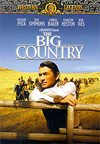The Big Country
MGM Home Entertainment
Cast: Gregory Peck, Charlton Heston, Carroll Baker, Burl Ives, Jean Simmons
Extras: Theatrical Trailer
Rating:
William Wyler’s epic Western ’The Big Country’ stars Gregory Peck as Jim McKay, an East Coast born sea captain engaged to Patricia Terrell (Carroll Baker), daughter of Texas cattle baron Henry Terrell (Charles Bickford). Trading in his sextant for a saddle, McKay moves out West to meet his future in-laws and set down roots. What McKay does not anticipate is that his betrothal places him squarely in the midst of a war. Both the ’cultured’ Terrells and the rural-living Hennessys, led by woolly patriarch Rufus (Burl Ives, in an Oscar-winning performance), are locked in a seemingly ageless battle over a vital watering hole called the Big Muddy. When the feud escalates into kidnapping and extortion, McKay springs into action in the best ’a man’s gotta do what a man’s gotta do’ Western tradition.
Starting with Saul Bass’ efficient opening credits (cross cutting close-ups of a stagecoach traveling at furious speed with Technirama wide shots of a dot inching along a blanched landscape), ’The Big Country’ upends one Western cliché after another. When Terrell’s foreman Steve Leech (a decidedly unsympathetic Charlton Heston) maneuvers McKay into a potentially embarrassing situation involving riding an untamed horse, McKay politely declines much to his very traditional fiancé’s dismay. He finally does ride Old Thunder…to his satisfaction and no one else’s. McKay and Leech’s confrontation (I won’t give away the how) succinctly embodies the film’s attitude about political folly and personal responsibility. Topical upon its first release in 1958, the battle between the Hennessys and the Terrells was a thinly veiled surrogate of the Cold War. Burl Ives’ fierce but honorable Rufus Hennessy counterpoints the traditional ’black stetson’ villain stereotype. There is even a touch of Shakespeare in the story with McKay as a kind of western ’Hamlet’ (no breakfast puns please!), accused of inaction but ready to take arms strictly by his own ethical dictates.
MGM Home Entertainment recently released the title on DVD and the disc’s 2.35 anamorphic transfer offers the cleanest video rendition I have ever seen. Image produced a widescreen laserdisc in 1996 and there is no comparison. The increased resolution of the format, along with 16×9 enhancement, yields an exceptionally stable and clear image. Keeping with the dusty atmosphere of Franz Planer’s expansive cinematography, colors are strong and accurate but not candied. Revival screenings in 1990 and earlier this year both projected worn prints so I was greatly relieved to see a virtually blemish-free master (I counted speckling in three spots). Fleshtones sometimes suffer, with faces too polished for continual outdoor exposure. The image exhibits some edge enhancement, but overall the transfer shows no digital or compression artifacts.
Controversy surrounds the film’s mono soundtrack, namely that a film of such magnitude would have been released in stereophonic sound. (Absent on the DVD, liner notes from the laserdisc discuss the lineage of the soundtrack.) The mono audio amply projects the dialogue and sound effects, but whatever fidelity existed on the original track thins out due to the Dolby Digital compression process. (In fact, the fatter PCM track on the laserdisc slightly edges out the DVD for richer audio.) Distortion occurs a few times and Jerome Moross’ lush, Academy-award winning music score lacks punch, sometimes clogging the center channel in the higher frequencies. With so many monophonic titles getting remixes these days, I wonder why MGM did not attempt audio remastering here.
The lack of special features truly disappoints. The laserdisc contained quite a few supplements, including behind the scenes featurettes (with footage of Peck and Ives playing chess between takes), previously recorded interviews with Charlton Heston and Burl Ives, extensive liner notes, and the theatrical trailer. Only the trailer survives the format migration. Presented in non-anamorphic widescreen, the typical exaggerated narration almost trivializes the subject matter.
Thoughtful and intelligent, ’The Big Country’ gives the viewer more to chew on than just oats. My only criticism of the DVD lies with the goodies; with so much material already made available in one format (and a dead one at that), the omission is all the more glaring. Why can’t video companies just get along and share their archival wealth with each other?







